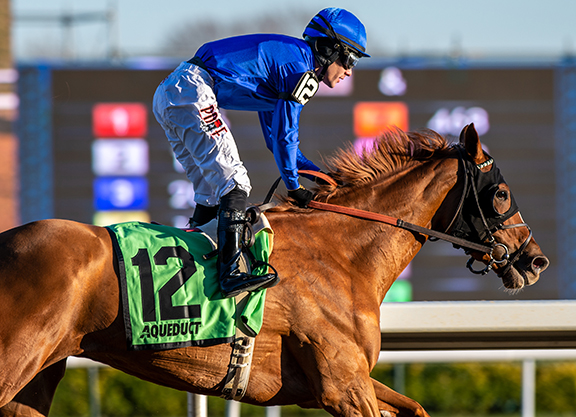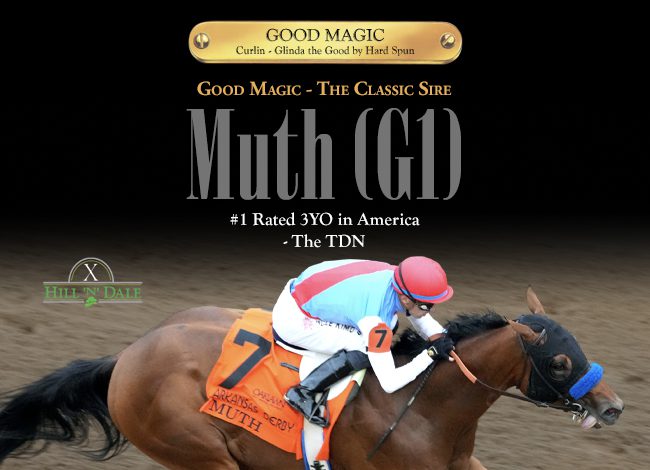By Chris McGrath
It is the sheer consistency of his output that has sustained Tapit's rise as a colossus of the modern breed: with his influence on the racetrack, first and foremost; with his corresponding impact in the sales ring (28 seven-figure yearlings); and next, judging from a promising start by several sons including star freshman Constitution, as a sire of sires.
When Lake Avenue laid down her Oaks marker the other day, with a four-length success in the GII Demoiselle S. at Aqueduct, Gainesway's multiple champion sire broke $150 million in lifetime progeny earnings.
So while this is Tapit's first year without a Grade I winner, it is still one in which only Into Mischief and Vino Rosso's sire Curlin have accumulated more purse money. Still more instructively, TDN's current table of North American sires by lifetime earnings shows not just that Tapit's $150 million milestone leaves him $15 million clear of his nearest pursuer, Distorted Humor. It also confirms his supremacy by earnings per named foal at $115,721, with only Curlin otherwise breaking six figures (at $100,770, albeit Speightstown is just a few cents short); by his 25 Grade I winners, putting him four ahead of War Front and Medaglia d'Oro; by his 52 Grade I performers, against 44 for Medaglia d'Oro; by his 78 graded stakes winners, outpunching Distorted Humor's 62; and by his 154 graded stakes horses, with only Distorted Humor (119), Medaglia d'Oro (108) and Malibu Moon (105) otherwise in three figures. Nobody, it seems, matches quality with quantity quite like Tapit.
His 19.41% black-type horses to named foals, meanwhile, is a ratio matched only (in fact, almost precisely) by War Front–whose books have, of course, been managed with wise conservatism.
Antony Beck and his Gainesway team deserve equal credit for grasping that both the breed and an individual stallion benefit from restraint, in terms of mares' access. They confined Tapit to 111 mares this year, and 113 in 2018.
Still pretty big numbers, of course, compared with the days of Mahmoud–whose portrait hangs adjacent to one of Tapit on Beck's office wall, highlighting the physical echoes that have filtered between the two grays. For many years the fastest Epsom Derby winner, Mahmoud once stood at Gainesway himself. And while Tapit had to earn his stripes in his second career–standing at $12,500 before launching his first runners–he has given himself every chance of illuminating future pedigrees with all the luster of his imported predecessor.
Beck plainly understands that your best chance of drawing repeatable assets from a pedigree is for its complex genetic tissue to entwine as many strands of class as possible. It's hard enough to predict coat color, after all, never mind the recurrence of more elusive qualities.
Tapit's first eight dams are gray, but the most conspicuous “knot” in his maternal line is his fourth dam Foggy Note. She was by Mahmoud's gray son The Axe, and dam of uniformly gray foals. But she is also a vital conduit of less superficial attributes, as the dam of Relaunch and his stakes-winning full sister Moon Glitter–whose daughter Ruby Slippers, in turn, produced Rubiano as well as Tapit's dam Tap Your Heels (Unbridled). Moon Glitter (In Reality) also enabled the largely forgotten Dewan briefly to extend a branch of Bold Ruler's line as dam of Glitterman.
Relaunch, Rubiano, Glitterman–one way or another, Beck knew that the unfulfilled track potential of Tapit, who made only half a dozen starts, was backed up by a family that had produced sires. And that consolidation of genetic class extends from top to bottom.
Besides Moon Glitter, Tapit's other great-granddams include broodmares of historic importance in Weekend Surprise and Narrate (both behind Tapit's sire Pulpit). And the fourth is Gana Facil, who figures as dam of Tapit's broodmare sire Unbridled but also produced a GI Wood Memorial winner (and leading regional sire) in Cahill Road. Which is no less than you would expect, given her own massively important family: Gana Facil's granddam Magic was a half-sister (by a mighty broodmare sire in Buckpasser) to Dr Fager and Ta Wee.
Ta Wee was by Intentionally and no doubt that influenced the choice of his son In Reality as a partner for Magic, producing Gana Facil's dam Charedi. And Charedi puts yet another stallion into Tapit's background, her son Pentelicus having served Ocala Stud as a source of trademark Florida speed.
Charedi, incidentally, was by the same sire as Moon Glitter. And In Reality also happens to be sire of the graded-stakes winning fourth dam of Lake Avenue–a filly who certainly looks eligible to redress Tapit's Grade I blank in 2019 as a sophomore next year.
Lake Avenue's family has enjoyed a transformation through her granddam Holiday Runner (Meadowlake), a $20,000 weanling and $35,000 yearling who won two juvenile stakes and then made $2.15 million in 2009 after her first foal Seventh Street (Street Cry {Ire}) won the GI Apple Blossom H. and GI Go For Wand H.
Seventh Street had been a lucrative pinhook, sold to Godolphin as a seven-figure juvenile within six months of making $100,000 at Keeneland September. And Holiday Runner's next foal also made big money as a 2-year-old, before eventually adding a Group 1 score of his own as Reynaldothewizard (Speightstown) in the 2013 Golden Shaheen. (Remarkably, he was still showing decent form at Meydan last year, when twice Group-placed as a 12-year-old.)
Unfortunately Holiday Runner yielded limited returns for her new owners, producing just a couple of other subsequent runners. But one of them, the Grade II-placed American Story (Ghostzapper), has contributed to the family's bloom by giving Tapit's son Concord Point his solitary Grade I winner, American Gal.
Her daughter's success in the 2017 Test S. qualified American Story for a $2.2 million sale to Don Alberto Corporation at Fasig-Tipton that November, with a predictable Tapit covering; while American Gal herself, having added another Grade I in the Humana Distaff, made $3 million to Whisper Hill Farm at the equivalent sale last year.
So this is a flourishing family, and Seventh Street herself has already contributed through Marking, her son by Bernardini. Although hardly by a sprint influence, Marking managed to split Runhappy (Super Saver) and Lord Nelson (Pulpit) in the GI Malibu S. And now Seventh Street has a new star in the making.
Lake Avenue had set up her stakes/two-turn debut with a 12 ¾ length maiden success over seven furlongs. The outside post did not prevent her seizing early control of the Demoiselle field, and what appears to be a very relaxed style helped her in comfortably handling this stiff test for a young filly. Tapit's stock are sometimes known for quirkiness but in the best that translates into sheer strength of will: they spread their full hand on the table, and ask the opposition to show what they have.
There's plenty of speed in Lake Avenue's family, as we've seen–a Bernardini sibling placed in the Malibu; a Golden Shaheen winner; American Gal's two Grade I sprints–but the sire of three Belmont winners, versatile as he is, has evidently done his bit in terms of that second turn.
Lake Avenue has an established Classic influence as her broodmare sire, too, in Street Cry; while the hulking but brilliant Meadowlake adds some interesting spice as sire of her second dam. Meadowlake evidently passed on too many structural strains to become a significant influence, but don't forget his dam was out of a half-sister to Hail To Reason. Perhaps there's a strand here usefully fortified by the elegance, athletic gusto and balance we associate with Tapit.
Lake Avenue's trainer Bill Mott was unlucky not to give Tapit his customary Grade I scorer this year with Tacitus, who emulated his sire in the Wood Memorial (these days a Grade II) and clearly belongs among the best of his generation. As it is, with an increasing number of Tapit's sons now competing at lower cost, breeders will appreciate Gainesway's temperate approach to the patriarch's fee, down to “just” $200,000 for 2020 from $300,000 a couple of years ago.
Of course, it's only the pricetag that changes. Tapit's genes are the same now as when he was an unproven $12,500 stallion. We've all seen new stallions set up with spectacular books, only to discover that the genetic switch is “off”. It was always “on” with Tapit, and always will be.
Sometimes, it's hard to unpick the wiring in the ones that make it. But those four great-granddams of his dovetail, in Tapit's pedigree, with Seattle Slew, Mr Prospector, Fappiano and Nijinsky. There is barely a brick missing, in fact, across the whole wall of 28 different sires listed in his first five generations.
Depth in his background, depth in his stock. If Tapit didn't get a real “headliner” this year, then there are 150 million reasons for awarding him one now.
Not a subscriber? Click here to sign up for the daily PDF or alerts.






